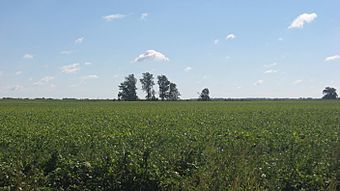Mayberry Mound and Village Site facts for kids
Quick facts for kids |
|
|
Mayberry Mound and Village Site
|
|

Comprehensive view from the west
|
|
| Location | Northeast of the junction of County Road 900E and the Skillet Fork |
|---|---|
| Nearest city | Sims, Illinois |
| Area | 90 acres (36 ha) |
| NRHP reference No. | 78001195 |
| Added to NRHP | November 21, 1978 |
The Mayberry Mound and Village Site is a really old and important place in Illinois, USA. It's an archaeological site, which means it's where scientists study things left behind by people who lived long, long ago. Near the town of Sims, this site was once a busy village during a time called the Archaic period. It's now a historic site because it helps us learn about ancient life.
What is the Mayberry Site?
The Mayberry Site is found on a low ridge called Fleming Ridge. It's not far from a stream known as the Skillet Fork. The main part of the site is a small hill, which is the "mound" in its name. This mound is about 80 meters (260 feet) long and 60 meters (200 feet) wide. It stands about 2 meters (6.5 feet) high.
Around the mound, the soil looks darker than other parts of the farm field. This darker soil suggests that people lived there a very long time ago. Even though some holes have been dug recently, the mound's shape is still mostly preserved.
Exploring the Site
In 1974, archaeologists from Southern Illinois University Museum explored the Mayberry Site. They did a "field survey," which means they walked around and looked for clues. They found many interesting things, called artifacts.
They found projectile points (like arrowheads), pieces of bones and shells, and charcoal. These finds helped them understand that the site was a village from the Archaic period. The mound itself seems to be a "midden." A midden is like an ancient trash pile, where people threw away their daily waste. This midden at Mayberry is about 1.5 meters (5 feet) deep. The dark soil around it was probably darkened by all the materials left behind by the villagers.
After the survey, local people shared an interesting discovery. They had found twelve skeletons buried in the southeastern part of the mound. These skeletons were placed in a way that they overlapped each other.
What We Learned
The archaeologists were very excited about what they found at Mayberry. The most important discovery was the idea that a whole village might be buried there. If scientists could dig deeper, they might learn a lot about how people lived during the Archaic period.
The size of the site is also very important. Mayberry covers about 90 acres, which is a huge area for an Archaic site in Illinois. This makes it one of the largest of its kind. The artifacts found were in excellent condition, and so were the skeletons.
Even though some parts of the site have been damaged (like the holes dug by people looking for treasures), most of the site is still intact. Because it has burials, a deep midden, and a possible village all close together, the Mayberry Site is very valuable for understanding history. Because of its importance, the site was added to the National Register of Historic Places in 1978. It is the only place in Wayne County on the Register, besides some houses in Fairfield.



